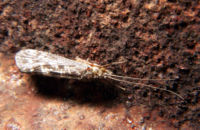
The impacts of chlorothalonil and diflubenzuron on Apis mellifera L. larvae reared in vitro.
Sign Up to like & getrecommendations! Published in 2018 at "Ecotoxicology and environmental safety"
DOI: 10.1016/j.ecoenv.2018.08.039
Abstract: Chlorothalonil is a broad-spectrum fungicide and diflubenzuron is an insect growth regulator used to control many insect larvae feeding on agricultural, forest and ornamental plants. Honey bee larvae may be exposed to both via contaminated… read more here.
Keywords: diflubenzuron; chlorothalonil diflubenzuron; larvae reared; mortality ... See more keywords

Effects of larval rearing substrates on some life-table parameters of Lutzomyia longipalpis sand flies.
Sign Up to like & getrecommendations! Published in 2021 at "PLoS neglected tropical diseases"
DOI: 10.1371/journal.pntd.0009034
Abstract: Sand flies are the insects responsible for transmitting Leishmania parasites, the causative agents of leishmaniasis in humans. However, the effects of sand fly breeding sites on their biology and ecology remain poorly understood. Herein, we… read more here.
Keywords: sand flies; breeding sites; larvae reared; lutzomyia longipalpis ... See more keywords